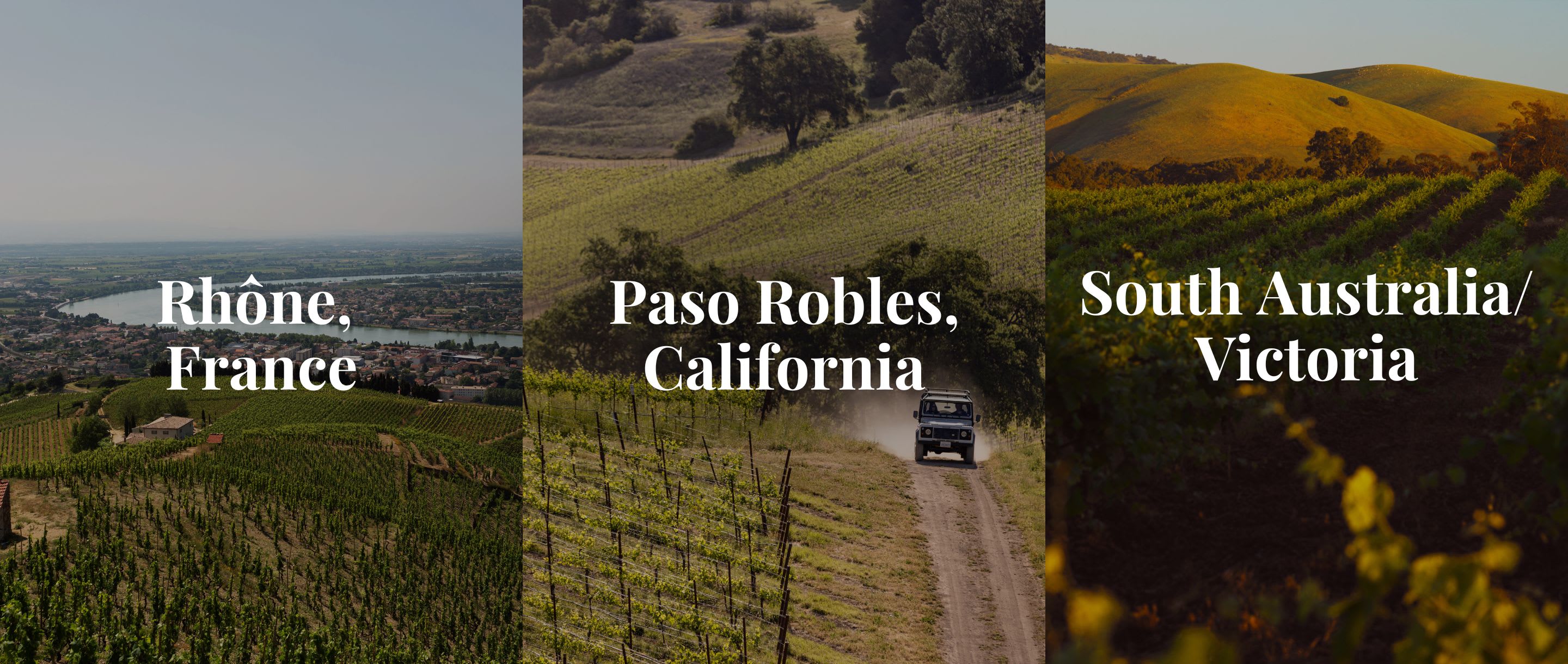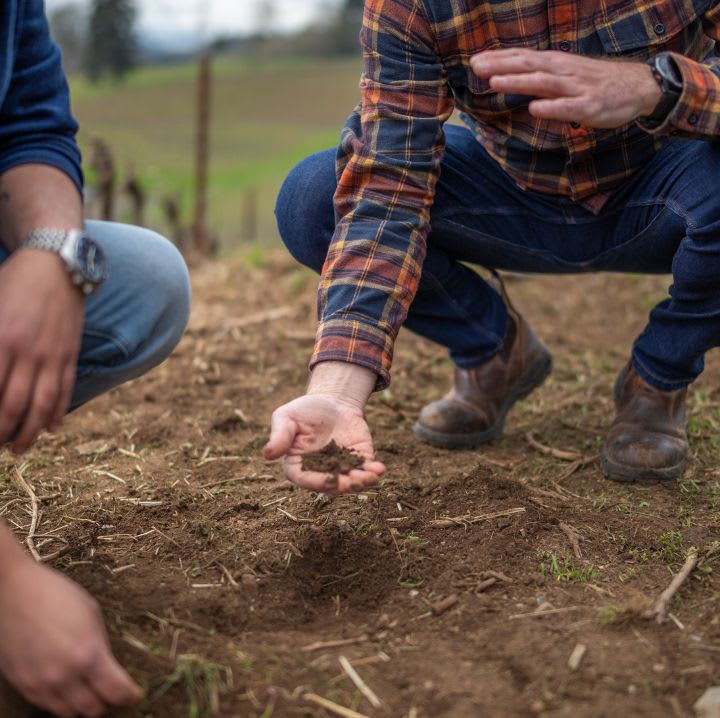Wine
Connect the Dots
Rhône, Paso Robles, and South Australia / Victoria
February 21, 2025

Here at Sommsation, we’re big believers that exploring and discovering new wines is just as exciting as drinking a wine we already know and love. We’re thrilled to announce our launch of Connect the Dots, a new series focused on introducing curious wine lovers to places, people, and bottles that we’re confident you’ll love.
For the third edition of our series, we’re connecting the dots between France’s Rhône Valley, Paso Robles, and the South Australia / Victoria regions of Australia. We know what you’re thinking – not even just three different countries, but three different continents? While it may seem extreme, you’ll be pleasantly surprised to learn just how many similarities these prestigious viticultural regions share!
Regional 101: Rhône, Paso Robles, and South Australia / Victoria
The key in finding similarities between regions is to first understand their foundations, so let’s start with the basics. France’s Rhône Valley is undeniably one of the most beloved regions in the world, and it’s certainly one of the country’s most complex. The valley is broken into two main sub-regions, the Northern Rhône and Southern Rhône, which are each home to a handful of highly regarded appellations and growing areas. However, while the Northern Rhône’s claim to fame is its powerhouse varietal Syrahs (as well as a handful of co-fermented expressions and white wines made with Viognier, Marsanne, and/or Roussanne), the Southern Rhône is recognized for its boisterous red and white blends, which span a vast flavor profile—and price—spectrum. Like many Old World regions, winemaking in the Rhône Valley dates back around 2,000 years.
Unsurprisingly, Paso Robles’ winegrowing history is much more recent. Located in sunny San Obispo County, wine grapes were first brought to the area during the late-18th century by European missionaries and conquerors. Commercial winemaking took off around a century later, though as with many of America’s industries, Paso’s wine-producing sector was rocked by two World Wars (and the imposition of Prohibition to boot). However, Paso Robles’ wine-making scene eventually recovered during the 1960s and 1970s, and today, is home to over 200 wineries.
Similar to Paso Robles, Australia’s premier wine-growing regions are also quite young. The first vines were planted in South Australia and Victoria in the mid-19th century, both by immigrants from England and Switzerland, respectively. These versatile regions are home to a diverse array of microclimates, soil types, and grape varieties, though one thing’s for sure—the wine industries of these two regions play a crucial role into the overall economic stability of these relatively isolated areas.
Terroir Specifics

The terroir specifics of the Rhône Valley, Paso Robles, and South Australia / Victoria share a number of similarities, though each is unique in its own right. With regards to the Rhône Valley, the Northern Rhône experiences an overall continental climate and is much cooler than the Southern Rhône, and is dominated by mostly clay and granite soils. On the other hand, the Southern Rhône is much warmer, sunnier, and experiences more Mediterranean climate conditions, which are characterized by mild winters and hot summers. Both areas of the Rhône are heavily impacted by the Mistral winds, as well as the region’s eponymous Rhône river.
Similar to the Southern Rhône, Paso Robles is also dominated by Mediterranean climate conditions, and also experiences mild winters and hot, dry summers. The entire AVA is located within San Luis Obispo County and is influenced by the nearby Santa Lucia mountain range, as well as the Salinas river, which creates a number of hills and valleys similar to the Rhône Valley.
Like the Rhône Valley, South Australia is prone to both ends of the spectrum, with inner parts of the region characterized by intense heat and coastal regions remaining tempered and cooler. Soil types are varied, though the region is known for its signature terra rossa (red clay) soils in Coonawarra, as well as limestone-marl near Adelaide and sandy clay-loam soils in barossa.
Grape Varieties
As with many of our Connect the Dots pieces, the most obvious thread that ties these three regions together is the grape varieties used. Grenache, Syrah, and Mourvèdre are key players in all three of these regions, with Syrah being the exclusive red grape of the Northern Rhône—and the star player of South Australia’s Barossa Valley, where it’s known as Shiraz (more on that in a second). When vinified together, these co-fermented wines are frequently referred to as GSM blends, and have made a serious name for themselves across all of the above regions.
So, what’s the difference between Syrah and Shiraz? Scientifically speaking, the grapes are one and the same, though each name implies a different growing region and style. For example, Syrah is mostly associated with Old World (and an increasing amount of New World) regions and styles—meaning lighter bodied, acid driven, and more savory, whereas Shiraz has become synonymous with Australian expressions, specifically those from Barossa and McLaren Vale. These wines tend to be fuller bodied, riper, and show more concentrated fruit flavors, thanks to their production in sunnier, warmer-climate areas. Despite being deemed “New World” regions, expressions from California and most of Chile are often labeled as Syrah to signify their leaner, more restrained flavor profiles.
Note: At Sommsation, our focus remains on independently-owned, responsibly-farmed estates, high-quality producers Below, we’ve outlined a few benchmark producers to know from each of the above regions, as well as have selected three Sommsation Picks to get you started on your journey.
Wineries to Know

Rhône Highlights
The Rhône Valley is home to a slew of highly regarded producers, though benchmark names in the Northern Rhône are Jean-Louis Chave, Michel Chaputier, Clusel-Roch, Alain Graillot, and Domaine Jamet. In the Southern Rhône, top names include Château Rayas, Château de Beaucastel, Eric Texier, and Domaine Gramenon.Paso Robles Highlights
Our go-to list of producers in Paso Robles includes Brecon Estate, Ancient Peaks, Adelaida Vineyards, and of course, Halter Ranch Winery.

Sommsation Pick: Halter Ranch Winery CDP 2020
Inspired by the great wines of the Southern Rhône, Halter Ranch’s CDP (which pays homage to the renowned appellation of Châteauneuf-du-Pape) is crafted from a classic GSM blend of Grenache, Syrah, and Mourvèdre, with a smidge of Tannat through in for good measure. Rich and ripe, the wine offers layered flavors of blackberry, blueberry, pomegranate, and herbs de Provence. To explore equally thought-provoking wines from Halter Ranch, spring for this Halter Ranch Winery 3-Pack. To check out the full Halter Ranch Winery lineup, click here.South Australia/Victoria Highlights
The Land Down Under is home to so many exciting wineries. A few of our South Australia / Victoria-based favorites include Living Roots, Jauma, Paxton Wines, Penfolds Grange, and Yangarra.
